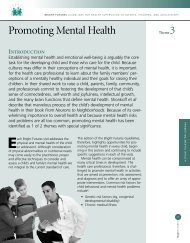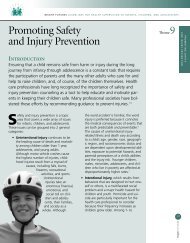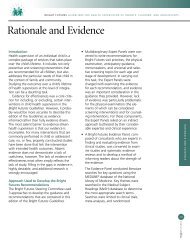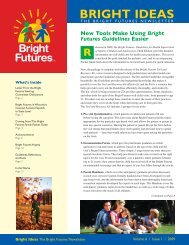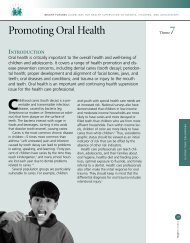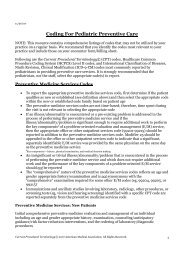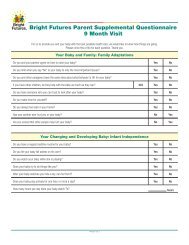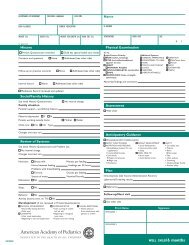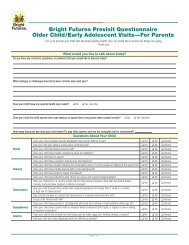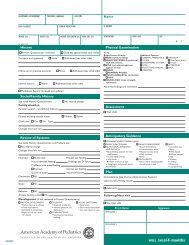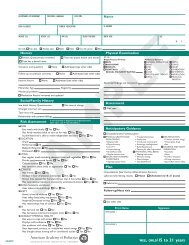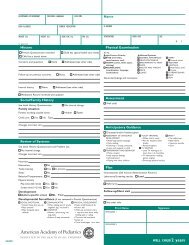POCKET GUIDE - Bright Futures - American Academy of Pediatrics
POCKET GUIDE - Bright Futures - American Academy of Pediatrics
POCKET GUIDE - Bright Futures - American Academy of Pediatrics
Create successful ePaper yourself
Turn your PDF publications into a flip-book with our unique Google optimized e-Paper software.
■■ infanCy<br />
oVerView<br />
infancy is divided into 3 stages. Physical growth, developmental<br />
achievements, nutrition needs, and feeding patterns<br />
vary significantly in each.<br />
Early infancy (birth–age 6 months). The most rapid changes<br />
occur during this stage.<br />
Middle infancy (ages 6–9 months). During this stage growth<br />
slows but is still rapid.<br />
Late infancy (ages 9–12 months). During this stage growth<br />
slows, but infants’ maturation and purposeful activity allow<br />
them to eat a wider variety <strong>of</strong> foods.<br />
■ infants usually regain their birth weight by 7 days after<br />
birth, double their birth weight by age 4 to 6 months, and<br />
triple their birth weight by age 1.<br />
■ infants usually increase their length by 50% in the first<br />
year, but the rate <strong>of</strong> increase slows during the second half<br />
<strong>of</strong> the year.<br />
■ growth rates <strong>of</strong> exclusively breastfed infants and formulafed<br />
infants differ. Breastfed infants grow more rapidly<br />
during the first half <strong>of</strong> the year but less rapidly during the<br />
second half.<br />
■ As infants grow, their ability to consume a greater volume<br />
and variety <strong>of</strong> food increases. Newborns need small, frequent<br />
feedings, whereas older infants are able to consume<br />
more volume at one time and require fewer feedings.<br />
■ infants learn to chew and swallow, manipulate finger foods,<br />
drink from a cup, and ultimately feed themselves.<br />
■ in late infancy, infants’ physical maturation, mastery <strong>of</strong><br />
purposeful activity, and loss <strong>of</strong> newborn reflexes allow<br />
them to eat a wider variety foods, including foods with<br />
different textures, than they were able to consume during<br />
early and middle infancy.<br />
■ Close physical contact between the infant and a parent<br />
during feeding facilitates healthy social and emotional<br />
development.<br />
■ The amount and type <strong>of</strong> physical activity that an infant<br />
engages in change dramatically during infancy.<br />
■ At first, infants spend most <strong>of</strong> their time sleeping and eating.<br />
over the next few months, infants slowly gain control<br />
over their movements. With increasing control comes<br />
more physical activity, including sitting up, rolling over,<br />
crawling, standing, and eventually walking.<br />
■ Development is an individual process. infants typically<br />
acquire motor skills in the same order, but the speed at<br />
which they acquire them is different.<br />
3<br />
<strong>Bright</strong> FUTURES<br />
Infancy



